Abstract
To solve the problem of the pavement being aged due to the influence of temperature, light and other environmental factors are brought in service. Nano-CaCO3 surface was activated by 6% KH-550, and nano-ZnO surface was activated by 6% aluminate. Nano-CaCO3/nano-ZnO/SBR composite-modified asphalt was prepared. The optimum proportion of composite-modified asphalt was determined by orthogonal test. The influence of modifiers on asphalt pavement performance was comprehensively studied. The microstructure of composite-modified asphalt was characterized by scanning electron microscopy and infrared spectroscopy. The mechanism of composite-modified asphalt was analyzed. The results show that the optimum combination of composite-modified asphalt is 4% nano-CaCO3 + 5% nano-ZnO + 4% SBR, the aging performance of the composite-modified asphalt is reduced by 6.9%, and the viscosity is increased by 14.6–23.1%. The complex shear modulus is increased by 24.1% at 82°C, the stiffness modulus is decreased, on average, by 21.1%. and the creep curve slope is increased by 9% on average. In the meantime, during the preparation process of composite-modified asphalt, it mainly occurred due to chemical reaction with surface-modified nanomaterials and physical change with SBR polymer materials.
1 Introduction
With the emergence of complex road environment, increased traffic volume, and worsening climate and environment in recent years, it is difficult for asphalt pavement to meet the use requirements. Asphalt pavement is aging due to temperature, light, water, and ultraviolet radiation in the service process, which result in the decrease of low-temperature crack resistance of asphalt pavement and the decrease of asphalt elasticity, affecting its road performance [1]. Therefore, it has great significance to improve the physical properties and antiaging performance of asphalt by adding modifiers to meet the safety of modern traffic.
Polymers similar to waste rubber powder are often added as modifiers in traditional asphalt pavement, which can improve asphalt performance to a certain extent, but have side effects in terms of aging performance [2]. In recent years, nanomaterials have been gradually tried to be added to polymer-modified asphalt and rely on their special physical and chemical properties, or compounded in matrix asphalt by adding multidimensional materials and nanomaterials, such as nano-clay, carbon nanotubes, and nano-MMT are combined with SBR to modify asphalt [3,4,5]. It is found that nanoparticles are uniformly dispersed in the asphalt material when the nanomaterials are added to the asphalt, which can effectively improve the high-temperature stability, low-temperature crack resistance, fatigue resistance, anti-skid capability, aging resistance, durability, water stability, and construction workability of asphalt [6,7,8,9,10]. SBR, as a common modifier, swells under the action of saturates and aromatic in asphalt, reacts with organic functional groups in asphalt, and generates new chemical bonds, thereby improving the low-temperature crack resistance and bonding performance of asphalt [11,12,13]. The multi-effect of nano-CaCO3 particles promotes the formation of strong van der Waals force with other molecules and forms a stable system. The high-temperature performance and aging resistance of asphalt are significantly improved by adding it [14,15,16]. Nano-ZnO shows superior performance in the field of optics, electricity, and magnetism. Adding nano-ZnO into asphalt can effectively improve the aging performance and chemical resistance [17,18]. The test shows that nano-ZnO can be uniformly distributed in asphalt to form a space reticulate structure. With the increase of nano-ZnO content, the high-temperature performance and viscosity-temperature characteristics of modified asphalt are improved more obviously [19]. In summary, SBR can effectively improve the low-temperature crack resistance of asphalt. Nano-CaCO3 improves the high-temperature performance of asphalt. Nano-ZnO not only helps to improve the high and low-temperature performance, but also plays a prominent role in antiaging and anti-fatigue performance.
Scholars have done a lot of research on improving the pavement performance of asphalt mixture and combined with mechanical software and computer simulation technology to carry out mechanical simulation analysis [20]. However, there are relatively few studies on the performance of asphalt alone and the improvement of its comprehensive performance. In addition, only a few scholars [21,22] have further explored the mechanism of asphalt modification. Thus, nano-CaCO3/nano-ZnO/SBR composite-modified asphalt was prepared. The effects of modifiers on aging performance, viscosity, high-temperature performance, and low-temperature performance were studied. The microstructure of composite-modified asphalt was analyzed. The modification mechanism of each modifier was revealed. In this paper, a series of studies are carried out in order to obtain composite modified asphalt with better performance, the basis for its wide application in engineering practice in the future.
2 Raw materials
2.1 Asphalt
The asphalt used in this paper is the domestic AK-70 asphalt of Zhengzhou Municipal Engineering Corporation (Asphalt Pavement Co., Ltd). The macro performance index test of asphalt is carried out according to the test procedure (JTG E20–2011) [23]. The test results are shown in Table 1.
Technical indicators of matrix asphalt
| Index | Unit | Test results | Technical requirements | |
|---|---|---|---|---|
| Penetration (25°C, 100 g, 5 s) | 0.1 mm | 61.5 | 60–80 | |
| Ductility (5 cm/min, 5°C) | cm | 11.6 | ≥0 | |
| Softening point | ℃ | 46.7 | ≥45 | |
| After TFOT | Quality change | % | 0.327 | −0.8 to +0.8 |
| Ductility (5°C) | cm | 7.9 | ≥6 | |
| Penetration ratio (25°C) | % | 68.8 | ≥61 | |
2.2 Nano-CaCO3
Nano-CaCO3 used in this paper is provided by Nanjing Epery Nanomaterials Co., Ltd, which is white powder; technical indicators are shown in Table 2.
Technical indicators of nano-CaCO3
| Test items | Test results | Technical requirements |
|---|---|---|
| Quality fraction of CaCO3 (%) | 99.5 | ≥95 |
| Average particle size of electron microscope (nm) | 80 | ≤80 |
| Specific surface area (m2/g) | 100 | ≥35 |
| Volatiles at 105°C (%) | 0.2 | ≤0.7 |
2.3 Nano-ZnO
In this paper, the white powder nano-ZnO is provided by Nanjing Epery Nanomaterials Co., Ltd.; technical indicators are shown in Table 3.
Technical indicators of nano-ZnO
| Test items | Test results | Technical requirements |
|---|---|---|
| Quality fraction of ZnO (%) | 99.5 | ≥95 |
| Average particle size of electron microscope (nm) | 15 | ≤80 |
| Specific surface area (m2/g) | 110 | ≥35 |
| Volatiles at 105°C (%) | 0.1 | ≤0.7 |
2.4 SBR
SBR is provided by Tianjin Ming Fund Tai Rubber and Plastic Technology Co., Ltd., which is rice white powder; technical indicators are shown in Table 4.
Technical indicators of SBR
| Test items | Color | Particle size (purpose) | Dry rubber content (%) | Combinated styrene (%) |
|---|---|---|---|---|
| Technical requirements | Observation | GB/T2916 | GB/T1040 | GB/T8658 |
| Test results | White | 30 | 100 | 17–19 |
3 Experimental
3.1 Preparation of composite-modified asphalt
3.1.1 Determination of optimum activation materials for nano-modifiers
The best coupling agent [24] is selected by comparison to conduct chemical modification on the surface of nanomaterials, which is conducive to better combination with asphalt. In this paper, KH-550, KH-570, and aluminate coupling agents were used to activate nanomaterials, and the best coupling agent was determined by lipophilicity test. Nano-CaCO3 modification method was as follows: 10 g nano-CaCO3 was weighed, and different doses of coupling agent solutions were configured. The mixed coupling agent solution was drained with a glass rod and added into three flasks. The electric stirrer was started for stirring at a constant speed of 100 rpm. Then, the nano-CaCO3 was slowly added into three flasks to fully contact with the coupling agent solutions. The electric stirrer was adjusted to 300 rpm and stirred at a constant speed for 10 min after the addition of nano-CaCO3, and then the heater was started up to 50°C and stirred for 20 min. After the stirring, the solutions were filtered out, and the remaining activated nano-CaCO3 was put into an electric drying oven for drying. The temperature was controlled at 100°C. After drying, it was ground for use. Nano-ZnO modification method was as follows: Nano-ZnO was dried in a 100°C electric hot air dryer for 12 h. Different doses of coupling agent solutions were configured, stirred by glass rods for 10 min and then added to three flasks, using electric stirring motor, stirred at room temperature for 5 min. Then nano-ZnO was slowly added to the flask, and the motor temperature was adjusted to 60–80°C; the speed was adjusted to 300 rpm, stirring for 40 min. The activated nano-ZnO was placed in an electric drying oven, and the temperature was controlled at 105°C for drying. Finally, the dried nano-ZnO was placed in a mortar for grinding.
3.1.2 Preparation of nano-CaCO3/nano-ZnO/SBR composite-modified asphalt
Adjust the temperature of heated asphalt to 80°C until all the asphalt melted for dehydration. After dehydration, a certain amount of matrix asphalt was weighed and placed on the heating base of a high-speed shear set at 135°C for no more than 30 min. In the heating process, glass rod was used to stir matrix asphalt to prevent asphalt aging due to local heating. The surface-modified nano-ZnO was added in the process of mixing. When it was integrated into asphalt, the high-speed shear was stabilized at 4,000 rpm and stirred for 15 min. After the high-speed stirring, the high-speed shear was adjusted to 1,500 rpm for stirring. At this time, the surface-modified nano-CaCO3 was gradually added. After the addition was completed, the speed of the high-speed shear was adjusted to 4,000 rpm, and the stirring time was 15 min. After it was fully integrated into the asphalt, the shear was closed, and the sample was naturally cooled and placed for about 24 h. On the second day, the sample was reheated to about 135°C, and the speed was set at 1,500 rpm to add the required dose of SBR. After stirring until it was fully integrated into asphalt, the speed was set at 4,500 rpm, and continuous shear stirring was carried out for 25 min. After stirring, the rotational speed is adjusted to 1,500 rpm, and the SBR was sheared for 10 min, so that the SBR was further refined under low-speed shear stirring, and finally the composite-modified asphalt was prepared.
Combined with the personal test and previous scholars’ summary [10,25] of the content test of the three modified materials in the matrix asphalt, the content of nano-CaCO3 was finally determined to be 4, 5, and 6%, the content of nano-ZnO was determined to be 1, 3, and 5%, and the content of SBR was determined to be 3, 4, and 5%. The essential performance tests of nano-CaCO3, nano-ZnO, and SBR with different doses were carried out. The optimal combination dosage of the three modifiers was obtained by orthogonal test [26]. Table 5 shows the dosage combination of each modifier in orthogonal test.
The dosage combination of each modifier
| Order number | Dosage (%) | ||
|---|---|---|---|
| Nano-CaCO3 | Nano-ZnO | SBR | |
| 1 | 4 | 1 | 3 |
| 2 | 4 | 3 | 4 |
| 3 | 4 | 5 | 5 |
| 4 | 5 | 1 | 4 |
| 5 | 5 | 3 | 5 |
| 6 | 5 | 5 | 3 |
| 7 | 6 | 1 | 5 |
| 8 | 6 | 3 | 3 |
| 9 | 6 | 5 | 4 |
3.2 Thin film oven test
According to the T 0609-2011 in the test procedure (JTG E20-2011) [23], the composite-modified asphalt was prepared. The aging test of 50 g composite-modified asphalt heated for 5 h at 163°C was carried out to study the aging resistance of composite-modified asphalt.
3.3 Brookfield viscosity test
Since this paper mainly studies the viscosity of asphalt at different temperatures, the Brookfield viscometer method, namely the rotational viscosity test, was adopted. According to the T 0625-2011 in the test procedure (JTG E20-2011) [23], under the temperature conditions of 110, 120, 130, 135, 140, 150, 160, 175, 185, and 190°C, the viscosity tests of matrix asphalt and composite-modified asphalt were carried out to obtain the variation trend of viscosity and study the influence of modifiers on viscosity-temperature characteristics.
3.4 Dynamic shear rheological test
According to the T 0628-2011 in the test procedure (JTG E20-2011) [23], the test used a large sample of 25 mm diameter and 1 mm thickness for temperature scanning. The loading frequency was 10 rad/s, the control strain was 1%, the temperature range was from 46 to 82°C, and each interval was 6°C. The complex shear modulus G*, phase angle δ, rutting factor G*/sin δ and other parameters of the matrix asphalt before and after aging, and the composite-modified asphalt before and after aging were tested by dynamic shear rheological to study the high-temperature performance of the composite-modified asphalt.
3.5 Bending beam rheological test (BBR)
All kinds of asphalt were prepared into samples (147 mm long, 12.7 mm wide, 6.35 mm thick), at the test temperature of 12°C, 18°C, 24°C under zero by loading, unloading and constant load control, the matrix asphalt, composite modified asphalt bending rheological test, so as to determine the bending creep stiffness modulus S and creep curve slope m, study the low temperature crack resistance of asphalt.
3.6 Test of SEM
The field emission scanning electron microscope (SEM) with the model of JSM-7500F was used to test the four kinds of asphalt, namely, matrix asphalt, nano-CaCO3-modified asphalt, nano-ZnO-modified asphalt, and SBR-modified asphalt. The distribution of single material in matrix asphalt can be compared and analyzed, and the microscopic observation of composite-modified asphalt can be carried out to distinguish the combination of the three materials with asphalt. In addition, through the analysis of the microstructure of these asphalts, the differences between them and the forces between various groups that may exist can be compared to determine whether the material and asphalt were chemically combined or physically combined.
3.7 Test of Fourier infrared spectrum
The infrared spectrum test and scanning analysis are carried out by the frontier Fourier infrared spectrometer, in which the wave number range is 4,000–400/cm, the resolution is 4/cm, and the scanning times are 64. The modification effect of coupling agent on nanomaterials and the reaction process with nanomaterials during the preparation of composite-modified asphalt were determined.
4 Test results and analysis
4.1 Optimum coupling agent and dosage of nanomaterials
Three kinds of coupling agents, KH-550, KH-570, and aluminate, were used to activate the surface of nanomaterials, and the best coupling agent and its dosage were determined by lipophilicity test. It can be seen from Figure 1 that the activation effect of KH-550 on nano-CaCO3 is better than that of KH-570 and aluminate, and the optimal dose is 6%. The activation effect of aluminate on nano-ZnO is better than that of KH-550 and KH-570, and the optimal dose is also 6%. Therefore, 6% KH-550-activated nano-CaCO3 and 6% aluminate-activated nano-ZnO are finally selected.
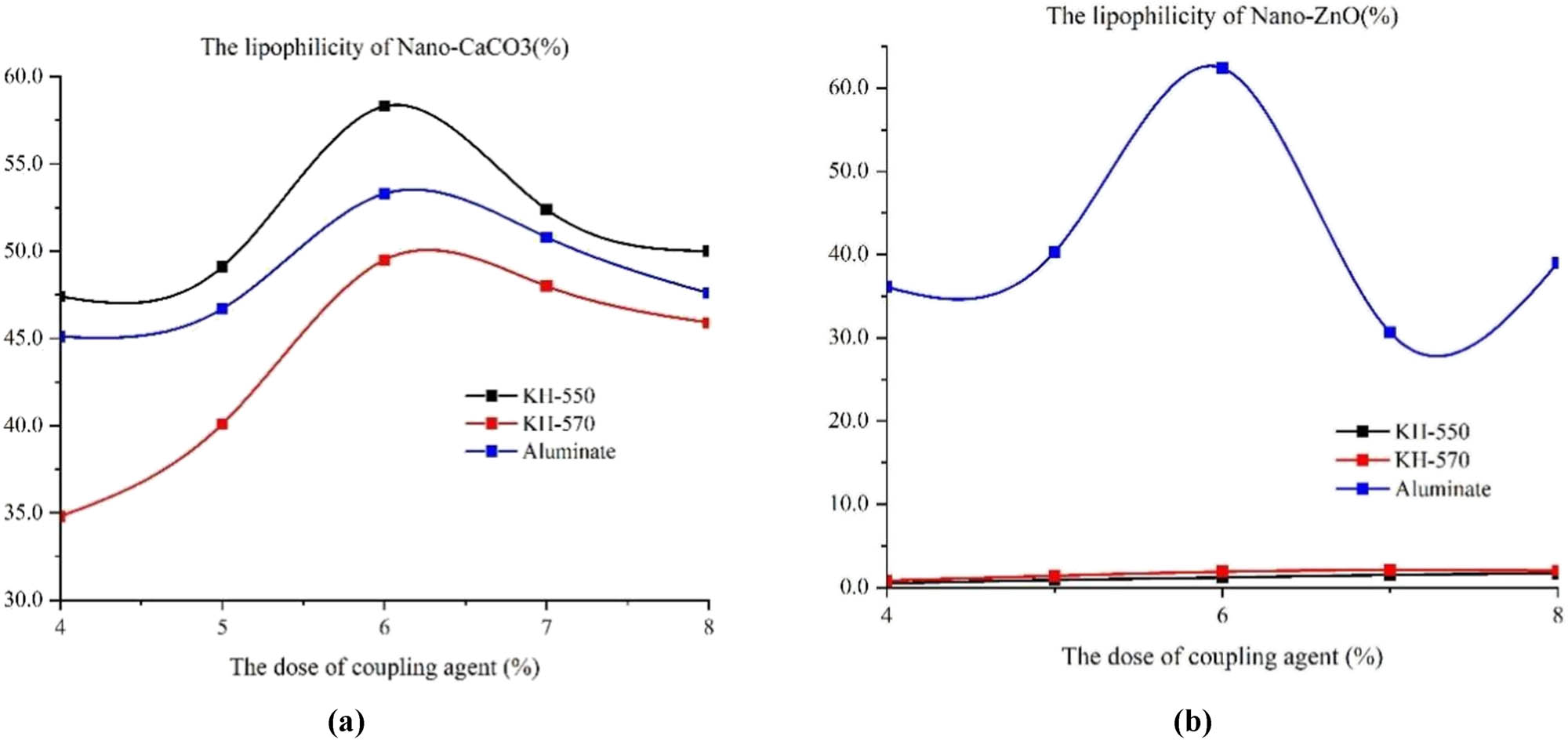
Lipophilic degree of activated nanomaterials: (a) lipophilic degree of activated nano-CaCO3 and (b) lipophilic degree of activated nano-ZnO.
4.2 Determination of optimum dosage combination
The penetration test, ductility test, and softening point test were carried out according to the dosage combination of each modifier in the orthogonal test determined in 3.2. Finally, the range analysis method was used to analyze the results of the orthogonal test, as shown in Table 6.
Range calculation results of orthogonal experiment
| Test items | Nano-CaCO3 | Nano-ZnO | SBR |
|---|---|---|---|
| (25°C, 100 g, 5 s) Penetration (0.1 mm) | |||
| K1 | 136.9 | 139.8 | 140.1 |
| K2 | 143.2 | 151.6 | 143.9 |
| K3 | 142.1 | 130.8 | 132.3 |
| k1 | 45.6 | 49.6 | 46.7 |
| k2 | 47.7 | 51.5 | 47.9 |
| k3 | 47.4 | 43.6 | 44.1 |
| Extreme difference | 2.1 | 7.9 | 3.8 |
| Optimization | 4% | 5% | 5% |
| Softening point (℃) | |||
| K1 | 159.8 | 156.7 | 158.2 |
| K2 | 158.1 | 159.6 | 158.9 |
| K3 | 156.8 | 158.4 | 157.6 |
| k1 | 53.3 | 52.3 | 52.7 |
| k2 | 52.7 | 53.2 | 53.0 |
| k3 | 52.3 | 52.8 | 52.5 |
| Extreme difference | 1.0 | 0.9 | 0.5 |
| Optimization | 4% | 3% | 4% |
| (5 cm/min, 5°C) Ductility (cm) | |||
| K1 | 42.3 | 42.1 | 42.2 |
| K2 | 42.4 | 41.2 | 43.2 |
| K3 | 41.0 | 42.4 | 40.3 |
| k1 | 14.1 | 14.0 | 14.1 |
| k2 | 14.1 | 13.7 | 14.4 |
| k3 | 13.6 | 14.1 | 13.4 |
| Extreme difference | 0.5 | 0.4 | 1.0 |
| Optimization | 5% | 5% | 4% |
Note: The value of K represents the total value of each factor at each level. The value of k represents the average value of the total value, and the value indicates the influence of this factor on the test parameters.
According to the penetration index, the optimal proportion results are: nano-CaCO3 content is 4%, nano-ZnO content is 5%, and SBR content is 5%. According to the softening point index, the optimal proportion results are: nano-CaCO3 content is 4%, nano-ZnO content is 3%, and SBR content is 4%. According to the ductility index, the optimum proportion results are: nano-CaCO3 content is 5%, nano-ZnO content is 5%, and SBR content is 4%. Considering the comprehensive balance method and economy, nano-CaCO3 mainly affects the high-temperature performance of asphalt, and the content of nano-CaCO3 is determined to be 4%. Nano-ZnO has a great influence on the aging resistance, and the content of nano-ZnO is determined to be 5%. SBR is the best to improve the low-temperature performance of asphalt, and the SBR content is 4%. Finally, the best combination dosage is: 4% nano-CaCO3 + 5% nano-ZnO + 4% SBR.
4.3 Analysis of aging performance
The performance test results of matrix asphalt and modified asphalt before and after aging are shown in Table 7. The mass loss of matrix asphalt under short-term aging condition of thin film heating oven is 0.327%, and the mass loss of composite-modified asphalt is 0.101%. From the test results of residual penetration ratio, the residual penetration ratio of matrix asphalt is 68.8%, the residual penetration ratio of composite-modified asphalt is 79.4%, and the residual penetration ratio of composite-modified asphalt is 15.4% higher than that of matrix asphalt. Through the ductility test, the ductility value of matrix asphalt after aging is 31.9% lower than that before aging, and the ductility value of composite-modified asphalt is 6.9% lower than that before aging, which shows that composite-modified asphalt can slow down the decrease of ductility value. It indicates that the addition of modifiers reduces the mass loss of matrix asphalt and increases the residual penetration ratio, which can effectively prevent asphalt aging and improve the antiaging performance.
Short-term aging test results of modified asphalt
| Asphalt type | Before aging | After aging | |||||
|---|---|---|---|---|---|---|---|
| Mass (g) | 25°C penetration (0.1 mm) | Ductility (cm) | Mass loss (%) | 25°C penetration (0.1 mm) | Residual penetration ratio (%) | Ductility (cm) | |
| 70 # asphalt | 49.851 | 61.5 | 11.6 | 0.327 | 42.3 | 68.8 | 7.9 |
| Composite-modified asphalt | 50.066 | 50.3 | 25.9 | 0.101 | 39.9 | 79.4 | 24.1 |
4.4 Analysis of Brookfield viscosity test
According to the 3.5, the viscosity test of matrix asphalt and composite-modified asphalt was carried out. The test results are shown in Figure 2. It can be seen that with the increase of temperature, the viscosity decreases gradually, but on the whole, the viscosity of the composite-modified asphalt is 14.6–23.1% higher than that of the matrix asphalt. Additionally, it can be seen that when the temperature is 135°C, the viscosity value of the composite-modified asphalt does not exceed 3 Pa·s, which is beneficial to the construction. Therefore, the viscosity of composite-modified asphalt is better. The increase of viscosity can enhance the ability of asphalt to resist shear deformation when it is added to the mixture, and its ability to resist rutting is also increased. It shows that the addition of modifiers can improve the high-temperature performance of asphalt and also has good construction performance.
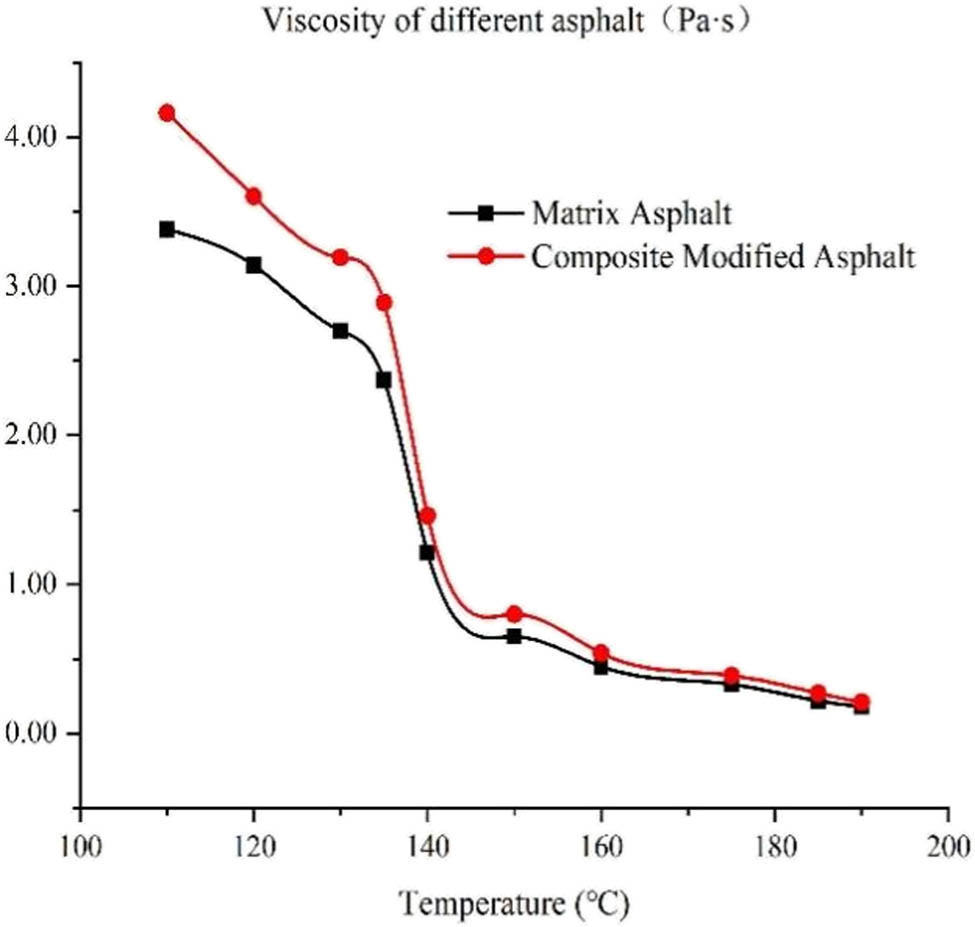
Results of Brookfield viscosity test.
4.5 Analysis of rheological property
4.5.1 Dynamic shear test results
According to the test method mentioned in 3.6, dynamic shear tests were carried out on four samples, and the results are shown in Figure 3. It shows that the complex shear modulus decreases and the phase angle increases with the increase of temperature before asphalt aging. When the temperature rises to 70°C, the value of matrix asphalt rutting factor G*/sin δ is 0.94 kPa, which is less than ≥1.0 kPa required by the test procedure (JTG E20-2011) [23]. On the contrary, the rutting factor G*/sin δ of composite-modified asphalt at 82°C is 1.14 kPa. Therefore, adding modifiers in asphalt can effectively resist rutting deformation, indicating that the addition of composite-modified materials improves the high-temperature performance of asphalt.
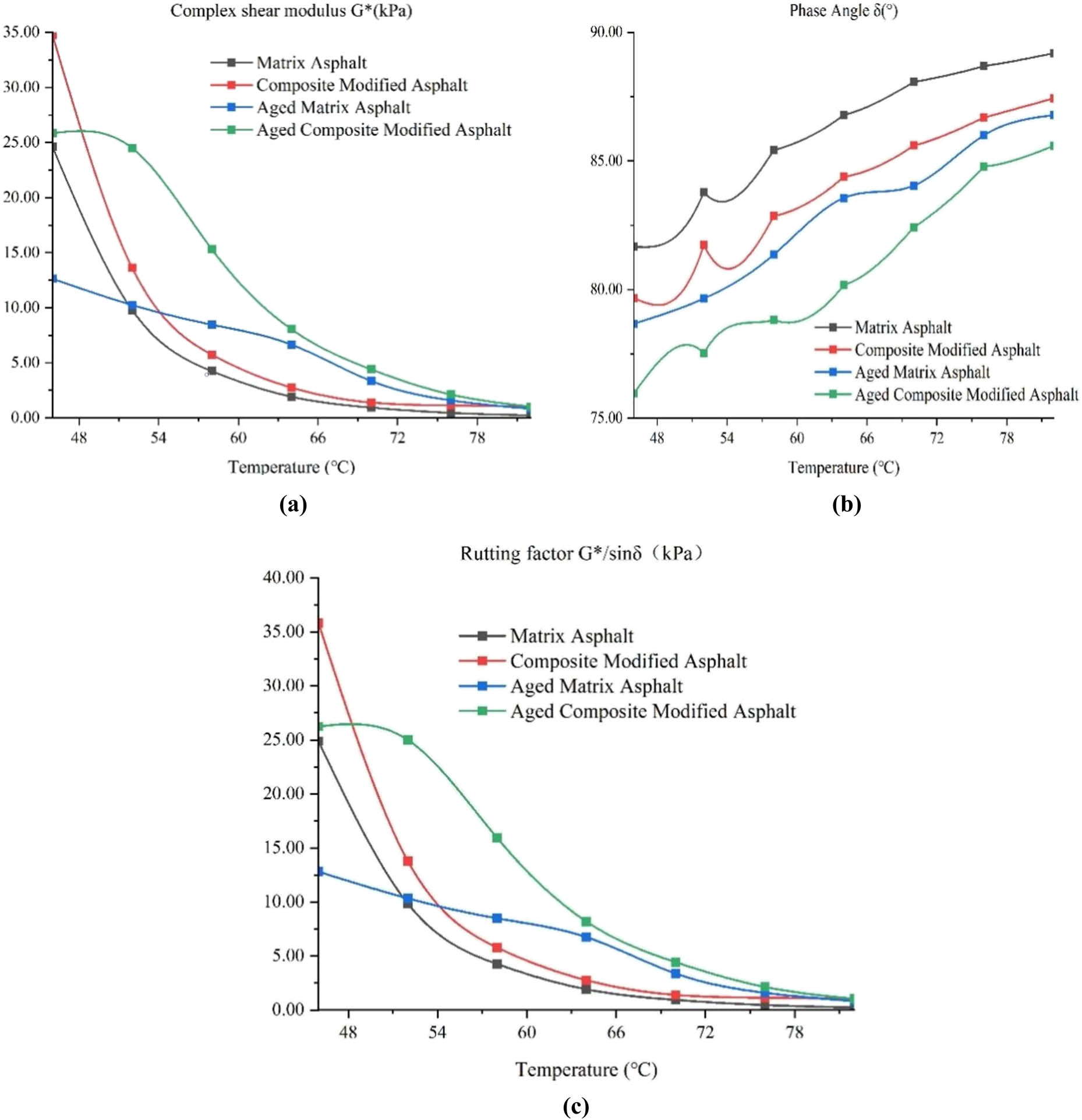
Different asphalts dynamic shear test results. (a) Different asphalts complex shear modulus, (b) different asphalts phase angle, and (c) different asphalts rutting factor.
After asphalt aging, the complex shear modulus G* of matrix asphalt and composite-modified asphalt gradually decrease with the increase of temperature, but at the same temperature, the complex shear modulus of composite-modified asphalt after aging is greater than that of matrix asphalt after aging. It illustrates that the shear deformation resistance of aged composite-modified asphalt is stronger than that of aged matrix asphalt. The phase angle of matrix asphalt and composite-modified asphalt after aging is smaller than that before aging, because the viscous and elastic components inside the matrix and composite-modified asphalt after aging are decreased, and the asphalt is slowly hardened, resulting in the decrease of phase angle. However, it is found that the phase angle of the aged composite-modified asphalt is smaller than that of the aged matrix asphalt, indicating that the elastic recovery ability of the modified asphalt is stronger than that of the matrix asphalt in the subsequent service process.
The rutting factor G*/sin δ of aged asphalt at 82°C is 0.84 kPa, while the rutting factor G*/sin δ of aged composite-modified asphalt at 82°C is 1.03 kPa, which is greater than ≥1.0 kPa required by T 0628-2011 in the test procedure (JTG E20-2011) [23]. It also reveals that the addition of modifiers can effectively slow down the rutting deformation and enhance the ability to resist rutting in short-term use.
In conclusion, the addition of modified materials can effectively resist rutting deformation and improve the high-temperature performance of asphalt.
4.5.2 Bending beam rheological test results
The bending beam rheological test results of matrix asphalt and modified asphalt are shown in Table 8. It can be seen that with the decrease of temperature, the stiffness modulus S values of composite-modified asphalt are smaller than that of matrix asphalt, and the decrease ratios are 15.6, 30.5, and 17.3% under three temperature conditions. Consequently, the addition of modifiers improves the relaxation ability of matrix asphalt at low temperature and improves the low-temperature crack resistance of asphalt. From the slope m values of creep curve, the m values of matrix asphalt and composite-modified asphalt gradually decrease with the decrease of temperature, and the m values of composite-modified asphalt are larger than that of matrix asphalt. However, compared with the matrix asphalt, the composite-modified asphalt increases by 10.2, 9.1, and 7.8% at different temperatures. It shows that modifiers are not easy to produce tensile stress due to temperature shrinkage deformation under low-temperature conditions. The addition of modifiers can improve the low-temperature crack resistance of asphalt.
Freeze-thaw test results of cement stabilized gangue mixture
| Asphalt type | Creep stiffness modulus S (MPa) | Creep curve slope m | ||||
|---|---|---|---|---|---|---|
| −12°C | −18°C | −24°C | −12°C | −18°C | −24°C | |
| 70 # Asphalt | 101.4 | 275.0 | 649.0 | 0.401 | 0.307 | 0.247 |
| Composite-modified asphalt | 85.7 | 191.0 | 537.0 | 0.442 | 0.335 | 0.266 |
4.6 Analysis of composite asphalt morphological characterization
4.6.1 Morphology characterization of matrix asphalt
Matrix asphalt is amplified 200 times image as Figure 4, there are no other substances or particles in the image, and the image surface is smooth and uniform.
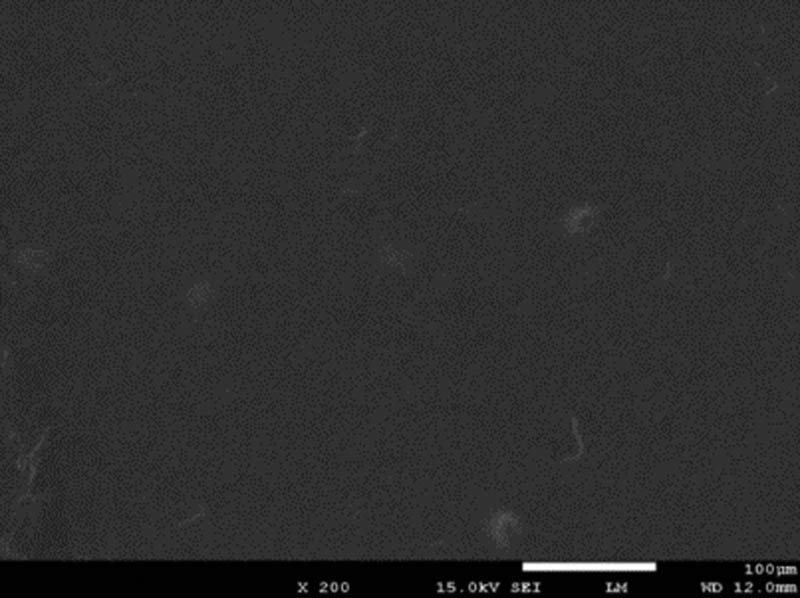
Image of matrix asphalt.
4.6.2 Morphology characterization of nano-CaCO3-modified asphalt
The partial amplification of nano-CaCO3-modified asphalt is 5,000 times as shown in Figure 5(a). It can be seen that there is a small amount of agglomeration in the figure, which also reflects that the effect of high-speed shear used in the early stage to modify nanomaterials does not reach 100%. But when amplifying another local nano-CaCO3-modified asphalt 10,000 times, as shown in Figure 5(b), it is found that it is uniformly dispersed in asphalt and some are wrapped in asphalt. Because of some characteristics of nanoparticles, the active particles are combined with the molecules in the asphalt to form a relatively stable network structure, which also makes the nano-CaCO3 particles form a continuous phase with the asphalt molecules, increasing the overall structure resistance to load and improving the thermal stability.
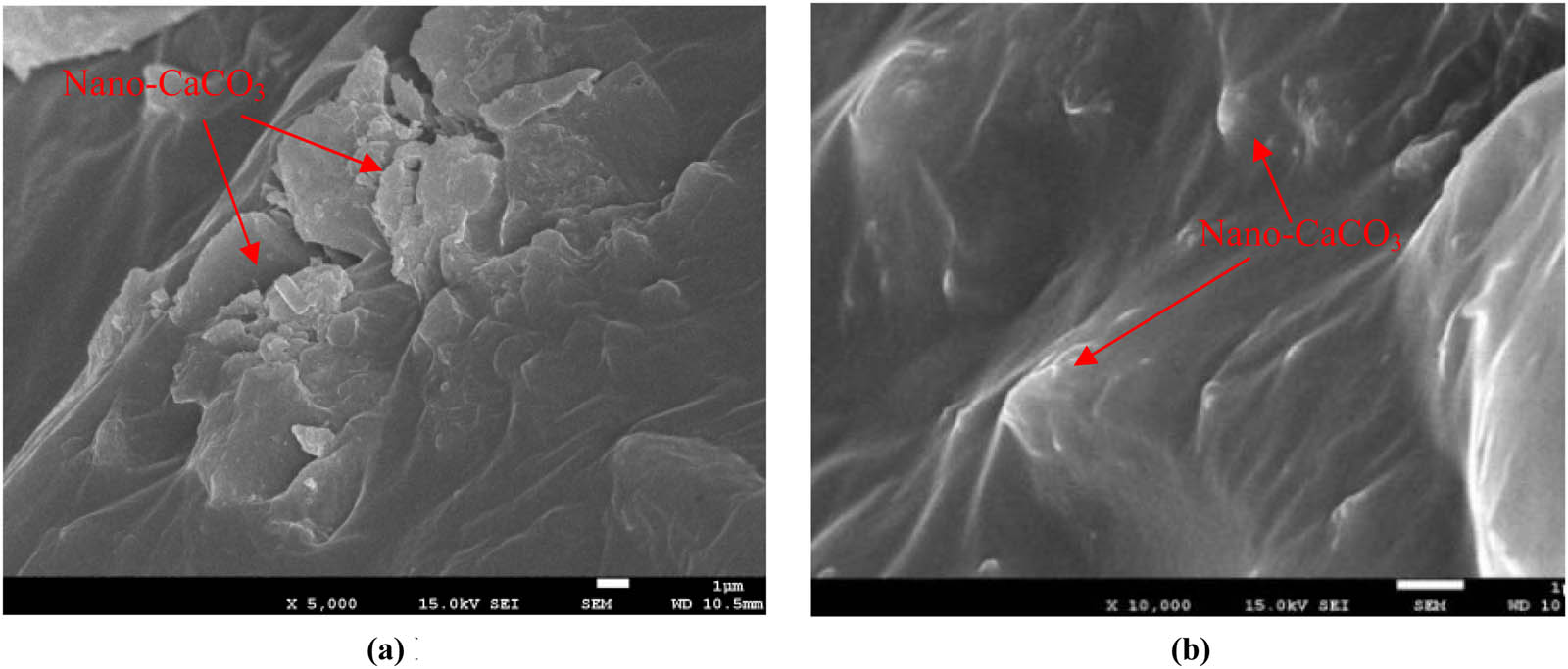
Different magnification images of nano-CaCO3-modified asphalt: (a) nano-CaCO3-modified asphalt amplifies 5,000 times and (b) nano-CaCO3-modified asphalt amplifies 10,000 times.
4.6.3 Morphology characterization of nano-ZnO-modified asphalt
The local amplification of nano-ZnO-modified asphalt is 2,000 times as Figure 6(a). It can be seen that there is a small amount of agglomeration in the figure, but the overall dispersion effect is still good. When amplifying another local nano-ZnO-modified asphalt 10,000 times, as shown in Figure 6(b), nano-ZnO is uniformly dispersed in asphalt and nano-ZnO and asphalt form a network structure, which may be due to the high-speed stirring of high-speed shear machine to destroy the structure of nano-ZnO particles, increase the surface activity of particles, and make it more closely combined with the asphalt interface. The destruction of nano-ZnO particles changes the chemical structures such as functional groups and covalent bonds and enhances the viscosity and toughness of modified asphalt, thereby improving the performance of asphalt.
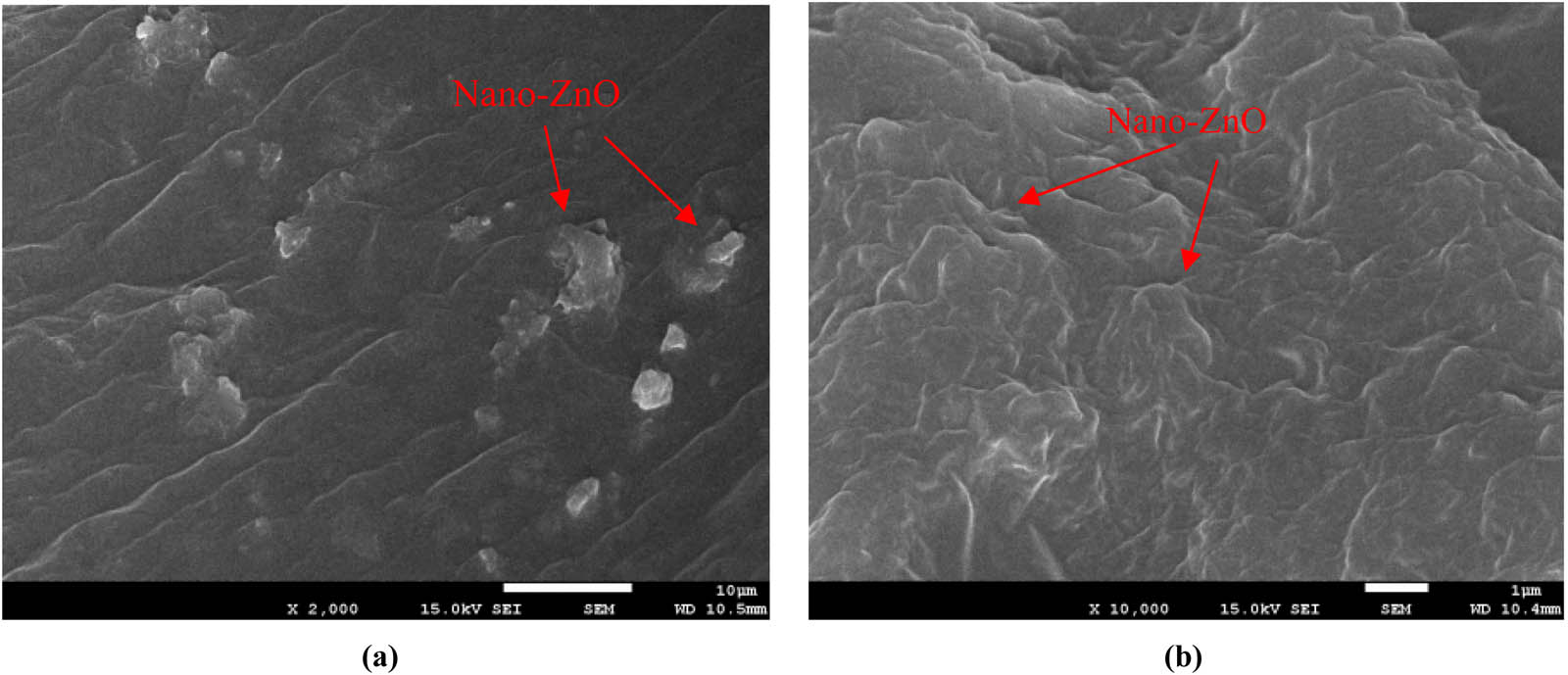
Different magnification images of nano-ZnO-modified asphalt: (a) nano-ZnO-modified asphalt amplifies 2,000 times and (b) nano-ZnO-modified asphalt amplifies 10,000 times.
4.6.4 Morphology characterization of SBR-modified asphalt
The two images in Figure 7 are amplified by 5,000 and 10,000 times of SBR-modified asphalt. It can be found that SBR is evenly distributed in asphalt which is due to the effect of shear, but it cannot be completely dissolved in it, just is filled in the asphalt in the state of elastic particles, so the surface looks a bit uneven. Nevertheless, the blending effect of SBR and matrix asphalt is still good.
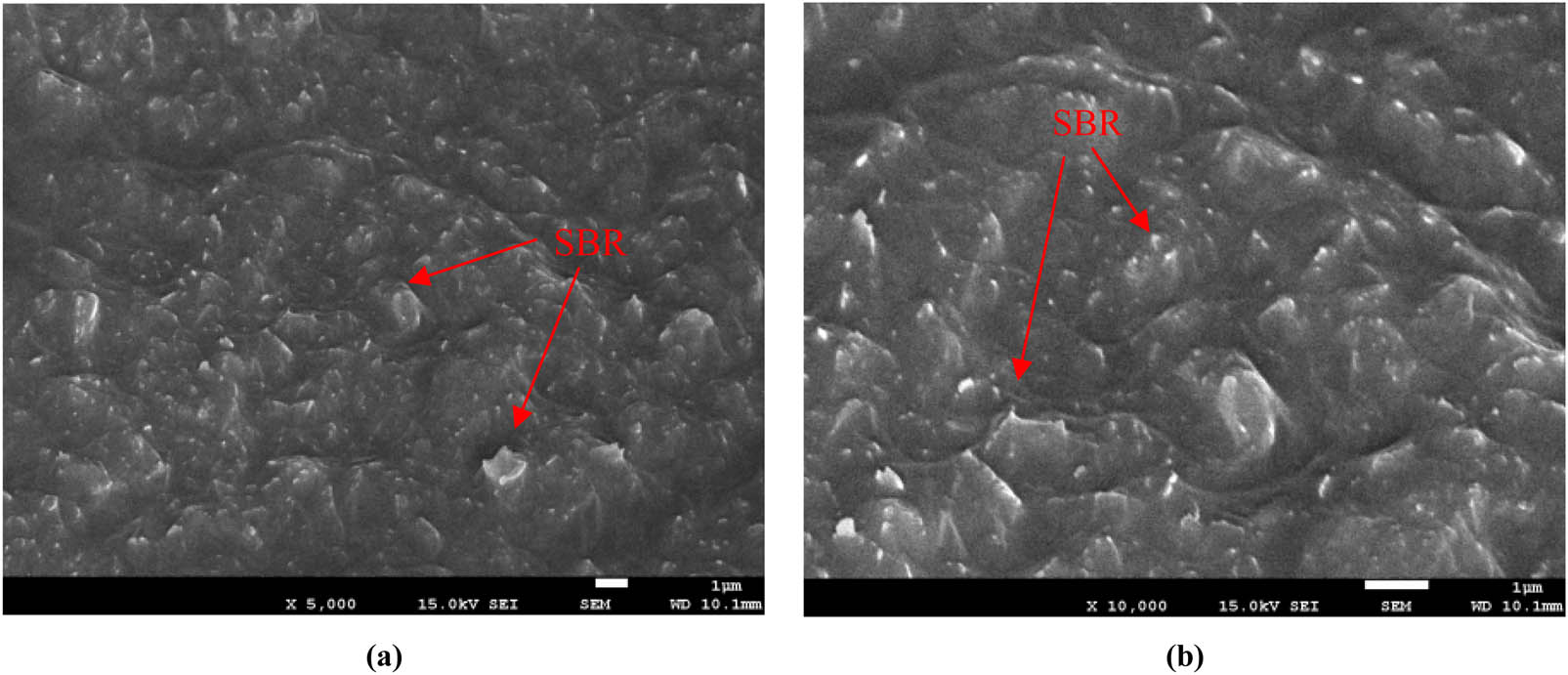
Different magnification images of SBR-modified asphalt. (a) SBR-modified asphalt amplifies 5,000 times and (b) SBR-modified asphalt amplifies 10,000 times.
4.6.5 Morphology characterization of nanomaterials/SBR composite-modified asphalt
When the composite-modified asphalt is amplified 5,000 times as shown in Figure 8(a), the shear effect of modifiers mixed together is better than that of nanomaterial alone. The composite-modified asphalt is amplified 20,000 times as shown in Figure 8(b). It is obvious that the three materials are basically completely fused with asphalt. Compared with the three materials alone, the interface layer of the composite-modified asphalt cannot be seen, which is the result of the interaction of the three materials. The network structure formed by nano-CaCO3 and nano-ZnO combined with the filling of SBR particles makes the stability of this structure better than before and the connection between modifiers and matrix asphalt smooth, which is also the reason for the better overall properties of composite-modified asphalt.
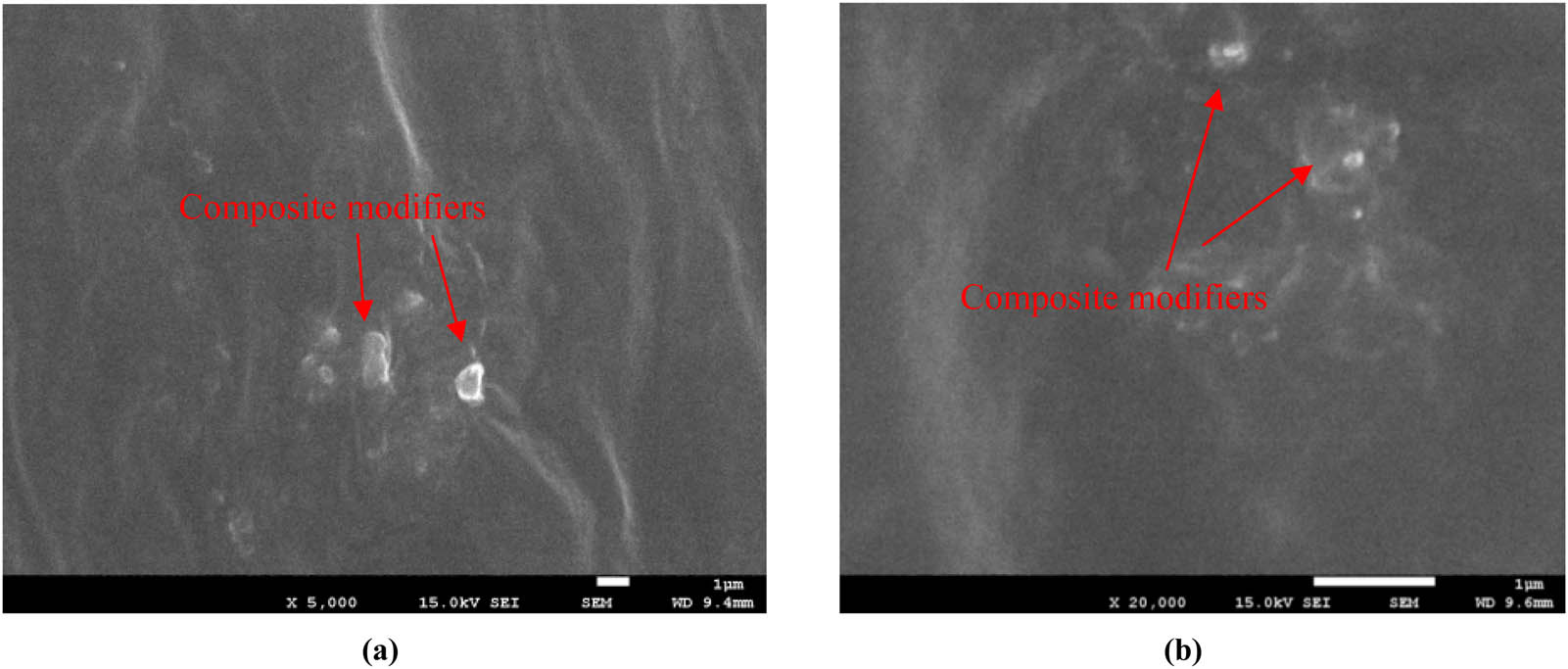
Different magnification images of composite-modified asphalt: (a) composite-modified asphalt amplifies 5,000 times and (b) composite-modified asphalt amplifies 20,000 times.
4.7 Analysis of Fourier infrared spectrum
According to the test requirement in 3.7, the modification effect of nanomaterials surface coupling agent can be analyzed, and the microscopic analysis of single modified asphalt and composite-modified asphalt can be carried out. Finally, the reaction process in the preparation of modified asphalt is obtained.
4.7.1 Analysis of modification effect of nanomaterials
It can be seen from Figure 9(a) that (1) the absorption peak of nano-CaCO3 before surface modification at 1,476/cm in the spectrum is due to the stretching vibration of C–O bond in
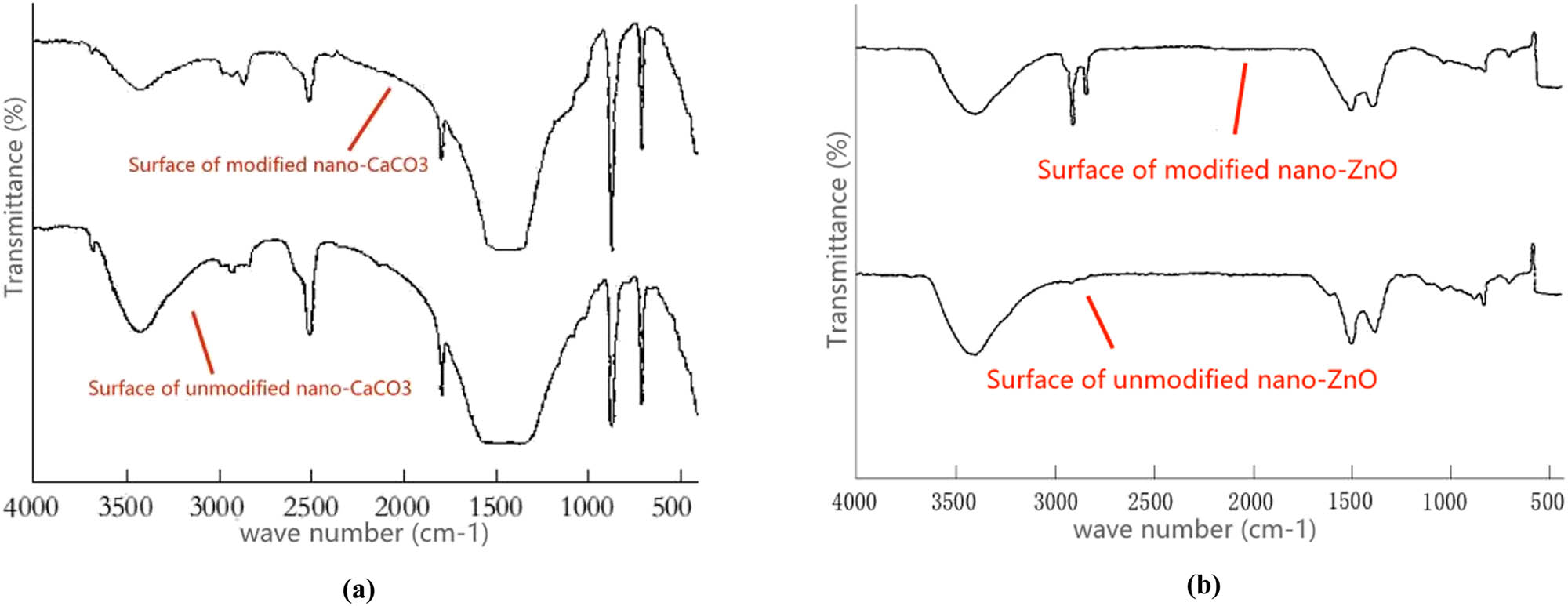
Infrared spectra of modification effect of nanomaterials: (a) IR spectra before and after surface modification of nano-CaCO3 and (b) IR spectra before and after surface modification of nano-ZnO.
It can be seen from Figure 9(b) that (1) the characteristic absorption peak of −OH at 3,450/cm is corresponding to the nano-ZnO before surface modification, and the absorption peak at 503/cm is caused by the stretching vibration of Zn–O bond. (2) Because of the stretching vibration of meth (–CH3) and methylene (–CH2–) in coupling agent, the surface-modified nano-ZnO produced new peaks at 2,784 and 2,910/cm. Therefore, it shows that the surface of nano-ZnO is introduced into the corresponding group of aluminates coupling agent, and they play a good role together.
4.7.2 Analysis of modified asphalt infrared spectrum
It can be clearly seen from Figure 10 that the peak values of matrix asphalt between 2,300–2,500 and 2,700–3,000/cm may be due to the vibration of C–H in paraffin hydrocarbons and cycloparaffins. The difference between modified asphalt and base asphalt is that the absorption peaks at 2,300–2,500 and 2,700–3,000/cm are gradually weakened, which may be mainly due to the chemical reaction between matrix asphalt and hydroxyl (–OH) in the modifier. By observing the infrared spectrum of nano-CaCO3-modified asphalt and nano-ZnO-modified asphalt, it can be found that there are absorption peaks between 3,300–3,500/cm. However, comparing with the spectrum of composite-modified asphalt, it can be found that the absorption peak disappeared, indicating that the chemical reaction between the surface-treated nanomaterials and the matrix asphalt has been occurred under the action of high-speed shear. There have been no obvious changes between the spectrum of SBR-modified asphalt and matrix asphalt, which shows that modifier SBR mainly occurs due to physical changes.
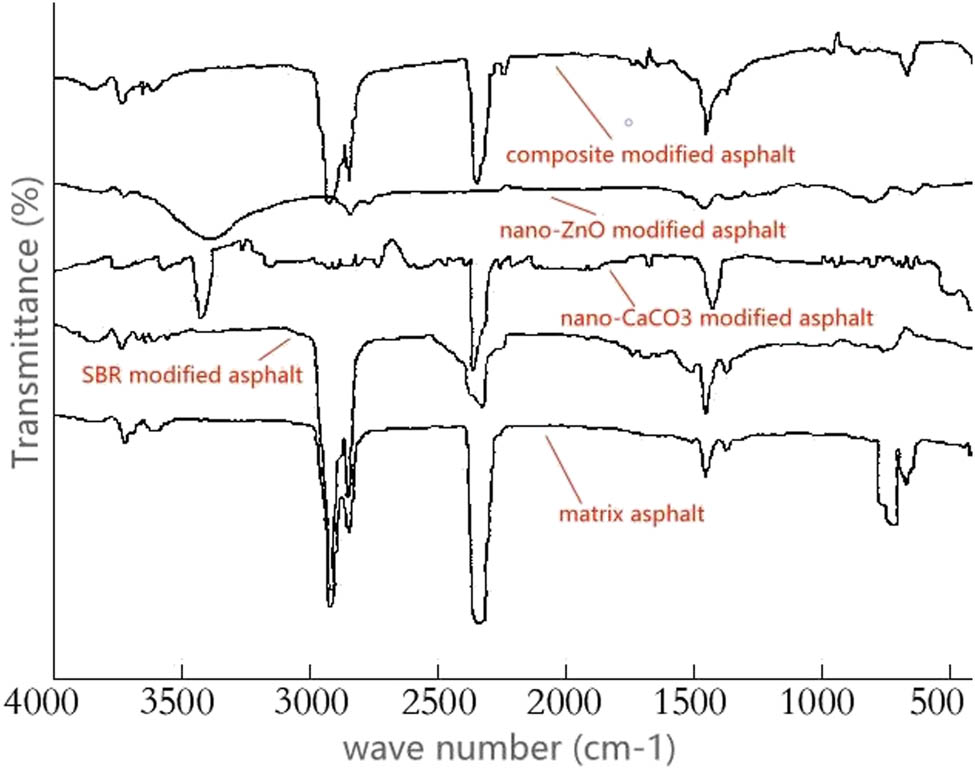
Infrared spectra of five types of asphalt.
It can be concluded that in the preparation process of composite-modified asphalt, the chemical reaction is mainly occurred with the surface-modified nanomaterials, and at the meantime, the physical reaction is occurred with SBR polymer materials.
5 Conclusion
The lipophilicity test finally determines that nano-CaCO3 is activated by 6% KH-550 and nano-ZnO is activated by 6% aluminate. The best combination dosage is as follows: 4% nano-CaCO3 + 5% nano-ZnO + 4% SBR. The aging performance of the composite-modified asphalt is reduced by 6.9%; the viscosity is increased by 14.6–23.1%. Compared with the matrix asphalt, the S values of the stiffness modulus of the low-temperature performance are reduced, and the decrease ratios are 15.6, 30.5, and 17.3% under three temperature conditions. It can be seen that the high-temperature performance, low-temperature performance, aging performance, and viscosity of composite-modified asphalt are better than those of matrix asphalt.
Through the Fourier infrared spectrum test, it is concluded that the chemical reaction mainly occurs between the composite-modified asphalt and the surface-modified nanomaterials, and the physical change occurs with SBR. Not only the three materials can be uniformly dispersed in asphalt, but also the network structure which is formed by nanomaterials combines with the filling of SBR particles and makes the structural stability of modified asphalt better. The connection of modifiers makes the performance of composite-modified asphalt better.
In the next step, the differential scanning calorimetry test of composite-modified asphalt can be analyzed. In addition, all experiments are carried out under relatively ideal environmental conditions in the laboratory. Therefore, a test road needs to be paved for practical verification to see whether its performance can be fully improved under actual environment conditions.
-
Funding information: This work was supported by Open Fund Project of Zhengzhou Environmentally Friendly High-Performance Road and Bridge Materials Laboratory: [Grant Number Zhengzhou Science [2018] No. 100]; Key R&D and Promotion of Special Scientific and Technological Research Projects of Henan Province: [Grant Number 182102310028, 182102210061]; Key Scientific Research Projects of Colleges and Universities in Henan Province in 2021: Study on Pavement Performance of Cotton Straw Cellulose-modified Asphalt [Grant Number 21A580004]; Open Fund Project of Henan Province Engineering Technology Research Center for Environment-Friendly and High-Performance Pavement Materials (Henan Science foundation [2020] No. 18).
-
Author contributions: Z. Li contributed to conceptualization, investigation, project administration, supervision, writing-review, and editing. T. Guo contributed to conceptualization, writing-original draft, supervision, visualization, and investigation. Y. Chen contributed to conceptualization, project administration, supervision, and investigation. Q. Liu contributed to conceptualization, supervision, and writing-original draft. Y. Chen: conceptualization, supervision, and investigation. All authors have accepted responsibility for the entire content of this manuscript and approved its submission.
-
Conflict of interest: The authors state no conflict of interest.
References
[1] Ma F, Dai JS, Fu Z, Liu J, Dong WH, Huang Z. A new type of crumb rubber asphalt mixture: a dry process design and performance evaluation. Appl Sci. 2020;10(1):372.10.3390/app10010372Search in Google Scholar
[2] Xu YQ, Li RM, Zheng CF. Review on application of nanomaterials in asphalt pavement. J China Foreign Highw. 2021;41(1):206–14.Search in Google Scholar
[3] Zhang HL, Su MM, Zhao SF, Zhang YP, Zhang ZP. High and low temperature properties of nano-particles/polymer modified asphalt. Constr Build Mater. 2016;114:323–32.10.1016/j.conbuildmat.2016.03.118Search in Google Scholar
[4] Mehmet S, Serdal T, Sebnem K. Examination of hot mix asphalt and binder performance modified with nano silica. Constr Build Mater. 2017;156:976–84.10.1016/j.conbuildmat.2017.09.069Search in Google Scholar
[5] Dalhat MA, Al Abdul Wahhab HI. Performance of recycled plastic waste modified asphalt binder in Saudi Arabia. Int J Pavement Eng. 2015;18(4):349–57.10.1080/10298436.2015.1088150Search in Google Scholar
[6] Wang J, Cai B, Ma HB. Preparation of nano-materials modified asphalt and the dispersion stabilization mechanism. Acta Pet Sin (Pet Process Sect). 2020;36(4):848–56.Search in Google Scholar
[7] Xu OM, Xiao FP, Han S, Serji NA, Wang ZJ. High temperature rheological properties of crumb rubber modified asphalt binders with various modifiers. Constr Build Mater. 2016;112:49–58.10.1016/j.conbuildmat.2016.02.069Search in Google Scholar
[8] Li RY, Xiao FP, Serji A, You ZP, Huang J. Developments of nano materials and technologies on asphalt materials – A review. Constr Build Mater. 2017;143:1–16.10.1016/j.conbuildmat.2017.03.158Search in Google Scholar
[9] Zhao BJ, Zhao SF, Zhang HL, Su MM. Properties and mechanism of composite asphalt modified by nano-CaCO3/SBR. J Chang’ an Univ (Nat Sci Ed). 2017;37(5):15–22.Search in Google Scholar
[10] Zhai RX, Ge LB, Li Y. The effect of nano-CaCO3/styrene–butadiene rubber (SBR) on fundamental characteristic of hot mix asphalt. Road Mater Pavement Des. 2020;21(4):1006–26.10.1080/14680629.2018.1532924Search in Google Scholar
[11] Zhang H. Evaluation of pavement performance of nano-ZnO/SBS modified asphalt mixture. J China Foreign Highw. 2016;36(02):289–92.Search in Google Scholar
[12] Zhang C, Wang HN, Yang X. Low-temperature performance of SBS modified asphalt mixture in high altitude and cold regions. Int J Pavement Res Technol. 2019;12(1):33–42.10.1007/s42947-019-0005-4Search in Google Scholar
[13] Liu CC, Lv ST, Jin DZ, Qu FT. Laboratory investigation for the road performance of asphalt mixtures modified by rock asphalt–styrene butadiene rubber. J Mater Civ Eng. 2021;33(3):1–10.10.1061/(ASCE)MT.1943-5533.0003611Search in Google Scholar
[14] Jin DZ, Qian GP, Bai XP. Progress in nano modified asphalt material. N Chem Mater. 2019;47(12):32–6.Search in Google Scholar
[15] Li ZJ, Yang ZN, Su JQ. Impact of organic modified nano-calcium carbonate on aging resistance of asphalt. Highw. 2018;63(11):259–64.Search in Google Scholar
[16] Yang ZN, Li ZJ, Li S. Effect of nano-CaCO3 on rheological properties of road petroleum asphalt. J China Foreign Highw. 2019;39(4):254–8.Search in Google Scholar
[17] Zhang XB, He XH, Jiang FY. Research progress in preparation and application of doped ZnO nanomaterials. N Chem Mater. 2021;3–5:1–6.Search in Google Scholar
[18] Chen YZ, Chen AJ, Li CJ, Li ZX. Analysis of performance for nano-zno modified asphalt mixture. China J Highw Transp. 2017;30(7):25–32.Search in Google Scholar
[19] Zhu QP. Preparation and properties analysis of asphalt modified by nano-ZnO. Appl Chem Ind. 2019;48(5):1031–4.Search in Google Scholar
[20] Yu HY, Ma T, Wang DW, Wang CH, Lu ST, Zhu XY, et al. Review on China’s pavement engineering research 2020. China J Highw Transp. 2020;33(10):1–66.Search in Google Scholar
[21] Wang CH, Chen Q, Guo TT, Li Q. Environmental effects and enhancement mechanism of graphene/tourmaline composites. J Clean Prod. 2020;262(5):1–12.10.1016/j.jclepro.2020.121313Search in Google Scholar
[22] Chen YZ, Wang Q, Li ZX, Ding SQ. Rhysiological properties of graphene nanoplatelets/rubber crowd composite modified asphalt. Constr Build Mater. 2020;261(5):1–12.10.1016/j.conbuildmat.2020.120505Search in Google Scholar
[23] TG E20-2011. Standard test methods of bitumen and bituminous mixtures for highway engineering. Beijing: China Communications Press; 2011.Search in Google Scholar
[24] Yang YQ, Tang XD, Tan XX, Hu XY, Xue JL, Guo B. Pavement performance of colored asphalt concrete modified with silane coupling agent. Highw. 2018;63(7):91–4.Search in Google Scholar
[25] Zhang XH. Study on properties of nano calcium carbonate modified asphalt and its mixture. J Changsha Univ Sci Technol (Nat Sci). 2017:1–57.Search in Google Scholar
[26] Fu Z, Chang XR, Dai JS, Dong WH, Zhou Y. Performance analysis of compound modified asphalt with sebs and crumb rubber based on orthogonal test. Sci Technol Eng. 2021;21(6):2445–51.Search in Google Scholar
© 2021 Zhenxia Li et al., published by De Gruyter
This work is licensed under the Creative Commons Attribution 4.0 International License.
Articles in the same Issue
- Research Articles
- Improved impedance matching by multi-componential metal-hybridized rGO toward high performance of microwave absorption
- Pure-silk fibroin hydrogel with stable aligned micropattern toward peripheral nerve regeneration
- Effective ion pathways and 3D conductive carbon networks in bentonite host enable stable and high-rate lithium–sulfur batteries
- Fabrication and characterization of 3D-printed gellan gum/starch composite scaffold for Schwann cells growth
- Synergistic strengthening mechanism of copper matrix composite reinforced with nano-Al2O3 particles and micro-SiC whiskers
- Deformation mechanisms and plasticity of ultrafine-grained Al under complex stress state revealed by digital image correlation technique
- On the deformation-induced grain rotations in gradient nano-grained copper based on molecular dynamics simulations
- Removal of sulfate from aqueous solution using Mg–Al nano-layered double hydroxides synthesized under different dual solvent systems
- Microwave-assisted sol–gel synthesis of TiO2-mixed metal oxide nanocatalyst for degradation of organic pollutant
- Electrophoretic deposition of graphene on basalt fiber for composite applications
- Polyphenylene sulfide-coated wrench composites by nanopinning effect
- Thermal conductivity and thermoelectric properties in 3D macroscopic pure carbon nanotube materials
- An effective thermal conductivity and thermomechanical homogenization scheme for a multiscale Nb3Sn filaments
- Friction stir spot welding of AA5052 with additional carbon fiber-reinforced polymer composite interlayer
- Improvement of long-term cycling performance of high-nickel cathode materials by ZnO coating
- Quantum effects of gas flow in nanochannels
- An approach to effectively improve the interfacial bonding of nano-perfused composites by in situ growth of CNTs
- Effects of nano-modified polymer cement-based materials on the bending behavior of repaired concrete beams
- Effects of the combined usage of nanomaterials and steel fibres on the workability, compressive strength, and microstructure of ultra-high performance concrete
- One-pot solvothermal synthesis and characterization of highly stable nickel nanoparticles
- Comparative study on mechanisms for improving mechanical properties and microstructure of cement paste modified by different types of nanomaterials
- Effect of in situ graphene-doped nano-CeO2 on microstructure and electrical contact properties of Cu30Cr10W contacts
- The experimental study of CFRP interlayer of dissimilar joint AA7075-T651/Ti-6Al-4V alloys by friction stir spot welding on mechanical and microstructural properties
- Vibration analysis of a sandwich cylindrical shell in hygrothermal environment
- Water barrier and mechanical properties of sugar palm crystalline nanocellulose reinforced thermoplastic sugar palm starch (TPS)/poly(lactic acid) (PLA) blend bionanocomposites
- Strong quadratic acousto-optic coupling in 1D multilayer phoxonic crystal cavity
- Three-dimensional shape analysis of peripapillary retinal pigment epithelium-basement membrane layer based on OCT radial images
- Solvent regulation synthesis of single-component white emission carbon quantum dots for white light-emitting diodes
- Xanthate-modified nanoTiO2 as a novel vulcanization accelerator enhancing mechanical and antibacterial properties of natural rubber
- Effect of steel fiber on impact resistance and durability of concrete containing nano-SiO2
- Ultrasound-enhanced biosynthesis of uniform ZnO nanorice using Swietenia macrophylla seed extract and its in vitro anticancer activity
- Temperature dependence of hardness prediction for high-temperature structural ceramics and their composites
- Study on the frequency of acoustic emission signal during crystal growth of salicylic acid
- Controllable modification of helical carbon nanotubes for high-performance microwave absorption
- Role of dry ozonization of basalt fibers on interfacial properties and fracture toughness of epoxy matrix composites
- Nanosystem’s density functional theory study of the chlorine adsorption on the Fe(100) surface
- A rapid nanobiosensing platform based on herceptin-conjugated graphene for ultrasensitive detection of circulating tumor cells in early breast cancer
- Improving flexural strength of UHPC with sustainably synthesized graphene oxide
- The role of graphene/graphene oxide in cement hydration
- Structural characterization of microcrystalline and nanocrystalline cellulose from Ananas comosus L. leaves: Cytocompatibility and molecular docking studies
- Evaluation of the nanostructure of calcium silicate hydrate based on atomic force microscopy-infrared spectroscopy experiments
- Combined effects of nano-silica and silica fume on the mechanical behavior of recycled aggregate concrete
- Safety study of malapposition of the bio-corrodible nitrided iron stent in vivo
- Triethanolamine interface modification of crystallized ZnO nanospheres enabling fast photocatalytic hazard-free treatment of Cr(vi) ions
- Novel electrodes for precise and accurate droplet dispensing and splitting in digital microfluidics
- Construction of Chi(Zn/BMP2)/HA composite coating on AZ31B magnesium alloy surface to improve the corrosion resistance and biocompatibility
- Experimental and multiscale numerical investigations on low-velocity impact responses of syntactic foam composites reinforced with modified MWCNTs
- Comprehensive performance analysis and optimal design of smart light pole for cooperative vehicle infrastructure system
- Room temperature growth of ZnO with highly active exposed facets for photocatalytic application
- Influences of poling temperature and elongation ratio on PVDF-HFP piezoelectric films
- Large strain hardening of magnesium containing in situ nanoparticles
- Super stable water-based magnetic fluid as a dual-mode contrast agent
- Photocatalytic activity of biogenic zinc oxide nanoparticles: In vitro antimicrobial, biocompatibility, and molecular docking studies
- Hygrothermal environment effect on the critical buckling load of FGP microbeams with initial curvature integrated by CNT-reinforced skins considering the influence of thickness stretching
- Thermal aging behavior characteristics of asphalt binder modified by nano-stabilizer based on DSR and AFM
- Building effective core/shell polymer nanoparticles for epoxy composite toughening based on Hansen solubility parameters
- Structural characterization and nanoscale strain field analysis of α/β interface layer of a near α titanium alloy
- Optimization of thermal and hydrophobic properties of GO-doped epoxy nanocomposite coatings
- The properties of nano-CaCO3/nano-ZnO/SBR composite-modified asphalt
- Three-dimensional metallic carbon allotropes with superhardness
- Physical stability and rheological behavior of Pickering emulsions stabilized by protein–polysaccharide hybrid nanoconjugates
- Optimization of volume fraction and microstructure evolution during thermal deformation of nano-SiCp/Al–7Si composites
- Phase analysis and corrosion behavior of brazing Cu/Al dissimilar metal joint with BAl88Si filler metal
- High-efficiency nano polishing of steel materials
- On the rheological properties of multi-walled carbon nano-polyvinylpyrrolidone/silicon-based shear thickening fluid
- Fabrication of Ag/ZnO hollow nanospheres and cubic TiO2/ZnO heterojunction photocatalysts for RhB degradation
- Fabrication and properties of PLA/nano-HA composite scaffolds with balanced mechanical properties and biological functions for bone tissue engineering application
- Investigation of the early-age performance and microstructure of nano-C–S–H blended cement-based materials
- Reduced graphene oxide coating on basalt fabric using electrophoretic deposition and its role in the mechanical and tribological performance of epoxy/basalt fiber composites
- Effect of nano-silica as cementitious materials-reducing admixtures on the workability, mechanical properties and durability of concrete
- Machine-learning-assisted microstructure–property linkages of carbon nanotube-reinforced aluminum matrix nanocomposites produced by laser powder bed fusion
- Physical, thermal, and mechanical properties of highly porous polylactic acid/cellulose nanofibre scaffolds prepared by salt leaching technique
- A comparative study on characterizations and synthesis of pure lead sulfide (PbS) and Ag-doped PbS for photovoltaic applications
- Clean preparation of washable antibacterial polyester fibers by high temperature and high pressure hydrothermal self-assembly
- Al 5251-based hybrid nanocomposite by FSP reinforced with graphene nanoplates and boron nitride nanoparticles: Microstructure, wear, and mechanical characterization
- Interlaminar fracture toughness properties of hybrid glass fiber-reinforced composite interlayered with carbon nanotube using electrospray deposition
- Microstructure and life prediction model of steel slag concrete under freezing-thawing environment
- Synthesis of biogenic silver nanoparticles from the seed coat waste of pistachio (Pistacia vera) and their effect on the growth of eggplant
- Study on adaptability of rheological index of nano-PUA-modified asphalt based on geometric parameters of parallel plate
- Preparation and adsorption properties of nano-graphene oxide/tourmaline composites
- A study on interfacial behaviors of epoxy/graphene oxide derived from pitch-based graphite fibers
- Multiresponsive carboxylated graphene oxide-grafted aptamer as a multifunctional nanocarrier for targeted delivery of chemotherapeutics and bioactive compounds in cancer therapy
- Piezoresistive/piezoelectric intrinsic sensing properties of carbon nanotube cement-based smart composite and its electromechanical sensing mechanisms: A review
- Smart stimuli-responsive biofunctionalized niosomal nanocarriers for programmed release of bioactive compounds into cancer cells in vitro and in vivo
- Photoremediation of methylene blue by biosynthesized ZnO/Fe3O4 nanocomposites using Callistemon viminalis leaves aqueous extract: A comparative study
- Study of gold nanoparticles’ preparation through ultrasonic spray pyrolysis and lyophilisation for possible use as markers in LFIA tests
- Review Articles
- Advance on the dispersion treatment of graphene oxide and the graphene oxide modified cement-based materials
- Development of ionic liquid-based electroactive polymer composites using nanotechnology
- Nanostructured multifunctional electrocatalysts for efficient energy conversion systems: Recent perspectives
- Recent advances on the fabrication methods of nanocomposite yarn-based strain sensor
- Review on nanocomposites based on aerospace applications
- Overview of nanocellulose as additives in paper processing and paper products
- The frontiers of functionalized graphene-based nanocomposites as chemical sensors
- Material advancement in tissue-engineered nerve conduit
- Carbon nanostructure-based superhydrophobic surfaces and coatings
- Functionalized graphene-based nanocomposites for smart optoelectronic applications
- Interfacial technology for enhancement in steel fiber reinforced cementitious composite from nano to macroscale
- Metal nanoparticles and biomaterials: The multipronged approach for potential diabetic wound therapy
- Review on resistive switching mechanisms of bio-organic thin film for non-volatile memory application
- Nanotechnology-enabled biomedical engineering: Current trends, future scopes, and perspectives
- Research progress on key problems of nanomaterials-modified geopolymer concrete
- Smart stimuli-responsive nanocarriers for the cancer therapy – nanomedicine
- An overview of methods for production and detection of silver nanoparticles, with emphasis on their fate and toxicological effects on human, soil, and aquatic environment
- Effects of chemical modification and nanotechnology on wood properties
- Mechanisms, influencing factors, and applications of electrohydrodynamic jet printing
- Application of antiviral materials in textiles: A review
- Phase transformation and strengthening mechanisms of nanostructured high-entropy alloys
- Research progress on individual effect of graphene oxide in cement-based materials and its synergistic effect with other nanomaterials
- Catalytic defense against fungal pathogens using nanozymes
- A mini-review of three-dimensional network topological structure nanocomposites: Preparation and mechanical properties
- Mechanical properties and structural health monitoring performance of carbon nanotube-modified FRP composites: A review
- Nano-scale delivery: A comprehensive review of nano-structured devices, preparative techniques, site-specificity designs, biomedical applications, commercial products, and references to safety, cellular uptake, and organ toxicity
- Effects of alloying, heat treatment and nanoreinforcement on mechanical properties and damping performances of Cu–Al-based alloys: A review
- Recent progress in the synthesis and applications of vertically aligned carbon nanotube materials
- Thermal conductivity and dynamic viscosity of mono and hybrid organic- and synthetic-based nanofluids: A critical review
- Recent advances in waste-recycled nanomaterials for biomedical applications: Waste-to-wealth
- Layup sequence and interfacial bonding of additively manufactured polymeric composite: A brief review
- Quantum dots synthetization and future prospect applications
- Approved and marketed nanoparticles for disease targeting and applications in COVID-19
- Strategies for improving rechargeable lithium-ion batteries: From active materials to CO2 emissions
Articles in the same Issue
- Research Articles
- Improved impedance matching by multi-componential metal-hybridized rGO toward high performance of microwave absorption
- Pure-silk fibroin hydrogel with stable aligned micropattern toward peripheral nerve regeneration
- Effective ion pathways and 3D conductive carbon networks in bentonite host enable stable and high-rate lithium–sulfur batteries
- Fabrication and characterization of 3D-printed gellan gum/starch composite scaffold for Schwann cells growth
- Synergistic strengthening mechanism of copper matrix composite reinforced with nano-Al2O3 particles and micro-SiC whiskers
- Deformation mechanisms and plasticity of ultrafine-grained Al under complex stress state revealed by digital image correlation technique
- On the deformation-induced grain rotations in gradient nano-grained copper based on molecular dynamics simulations
- Removal of sulfate from aqueous solution using Mg–Al nano-layered double hydroxides synthesized under different dual solvent systems
- Microwave-assisted sol–gel synthesis of TiO2-mixed metal oxide nanocatalyst for degradation of organic pollutant
- Electrophoretic deposition of graphene on basalt fiber for composite applications
- Polyphenylene sulfide-coated wrench composites by nanopinning effect
- Thermal conductivity and thermoelectric properties in 3D macroscopic pure carbon nanotube materials
- An effective thermal conductivity and thermomechanical homogenization scheme for a multiscale Nb3Sn filaments
- Friction stir spot welding of AA5052 with additional carbon fiber-reinforced polymer composite interlayer
- Improvement of long-term cycling performance of high-nickel cathode materials by ZnO coating
- Quantum effects of gas flow in nanochannels
- An approach to effectively improve the interfacial bonding of nano-perfused composites by in situ growth of CNTs
- Effects of nano-modified polymer cement-based materials on the bending behavior of repaired concrete beams
- Effects of the combined usage of nanomaterials and steel fibres on the workability, compressive strength, and microstructure of ultra-high performance concrete
- One-pot solvothermal synthesis and characterization of highly stable nickel nanoparticles
- Comparative study on mechanisms for improving mechanical properties and microstructure of cement paste modified by different types of nanomaterials
- Effect of in situ graphene-doped nano-CeO2 on microstructure and electrical contact properties of Cu30Cr10W contacts
- The experimental study of CFRP interlayer of dissimilar joint AA7075-T651/Ti-6Al-4V alloys by friction stir spot welding on mechanical and microstructural properties
- Vibration analysis of a sandwich cylindrical shell in hygrothermal environment
- Water barrier and mechanical properties of sugar palm crystalline nanocellulose reinforced thermoplastic sugar palm starch (TPS)/poly(lactic acid) (PLA) blend bionanocomposites
- Strong quadratic acousto-optic coupling in 1D multilayer phoxonic crystal cavity
- Three-dimensional shape analysis of peripapillary retinal pigment epithelium-basement membrane layer based on OCT radial images
- Solvent regulation synthesis of single-component white emission carbon quantum dots for white light-emitting diodes
- Xanthate-modified nanoTiO2 as a novel vulcanization accelerator enhancing mechanical and antibacterial properties of natural rubber
- Effect of steel fiber on impact resistance and durability of concrete containing nano-SiO2
- Ultrasound-enhanced biosynthesis of uniform ZnO nanorice using Swietenia macrophylla seed extract and its in vitro anticancer activity
- Temperature dependence of hardness prediction for high-temperature structural ceramics and their composites
- Study on the frequency of acoustic emission signal during crystal growth of salicylic acid
- Controllable modification of helical carbon nanotubes for high-performance microwave absorption
- Role of dry ozonization of basalt fibers on interfacial properties and fracture toughness of epoxy matrix composites
- Nanosystem’s density functional theory study of the chlorine adsorption on the Fe(100) surface
- A rapid nanobiosensing platform based on herceptin-conjugated graphene for ultrasensitive detection of circulating tumor cells in early breast cancer
- Improving flexural strength of UHPC with sustainably synthesized graphene oxide
- The role of graphene/graphene oxide in cement hydration
- Structural characterization of microcrystalline and nanocrystalline cellulose from Ananas comosus L. leaves: Cytocompatibility and molecular docking studies
- Evaluation of the nanostructure of calcium silicate hydrate based on atomic force microscopy-infrared spectroscopy experiments
- Combined effects of nano-silica and silica fume on the mechanical behavior of recycled aggregate concrete
- Safety study of malapposition of the bio-corrodible nitrided iron stent in vivo
- Triethanolamine interface modification of crystallized ZnO nanospheres enabling fast photocatalytic hazard-free treatment of Cr(vi) ions
- Novel electrodes for precise and accurate droplet dispensing and splitting in digital microfluidics
- Construction of Chi(Zn/BMP2)/HA composite coating on AZ31B magnesium alloy surface to improve the corrosion resistance and biocompatibility
- Experimental and multiscale numerical investigations on low-velocity impact responses of syntactic foam composites reinforced with modified MWCNTs
- Comprehensive performance analysis and optimal design of smart light pole for cooperative vehicle infrastructure system
- Room temperature growth of ZnO with highly active exposed facets for photocatalytic application
- Influences of poling temperature and elongation ratio on PVDF-HFP piezoelectric films
- Large strain hardening of magnesium containing in situ nanoparticles
- Super stable water-based magnetic fluid as a dual-mode contrast agent
- Photocatalytic activity of biogenic zinc oxide nanoparticles: In vitro antimicrobial, biocompatibility, and molecular docking studies
- Hygrothermal environment effect on the critical buckling load of FGP microbeams with initial curvature integrated by CNT-reinforced skins considering the influence of thickness stretching
- Thermal aging behavior characteristics of asphalt binder modified by nano-stabilizer based on DSR and AFM
- Building effective core/shell polymer nanoparticles for epoxy composite toughening based on Hansen solubility parameters
- Structural characterization and nanoscale strain field analysis of α/β interface layer of a near α titanium alloy
- Optimization of thermal and hydrophobic properties of GO-doped epoxy nanocomposite coatings
- The properties of nano-CaCO3/nano-ZnO/SBR composite-modified asphalt
- Three-dimensional metallic carbon allotropes with superhardness
- Physical stability and rheological behavior of Pickering emulsions stabilized by protein–polysaccharide hybrid nanoconjugates
- Optimization of volume fraction and microstructure evolution during thermal deformation of nano-SiCp/Al–7Si composites
- Phase analysis and corrosion behavior of brazing Cu/Al dissimilar metal joint with BAl88Si filler metal
- High-efficiency nano polishing of steel materials
- On the rheological properties of multi-walled carbon nano-polyvinylpyrrolidone/silicon-based shear thickening fluid
- Fabrication of Ag/ZnO hollow nanospheres and cubic TiO2/ZnO heterojunction photocatalysts for RhB degradation
- Fabrication and properties of PLA/nano-HA composite scaffolds with balanced mechanical properties and biological functions for bone tissue engineering application
- Investigation of the early-age performance and microstructure of nano-C–S–H blended cement-based materials
- Reduced graphene oxide coating on basalt fabric using electrophoretic deposition and its role in the mechanical and tribological performance of epoxy/basalt fiber composites
- Effect of nano-silica as cementitious materials-reducing admixtures on the workability, mechanical properties and durability of concrete
- Machine-learning-assisted microstructure–property linkages of carbon nanotube-reinforced aluminum matrix nanocomposites produced by laser powder bed fusion
- Physical, thermal, and mechanical properties of highly porous polylactic acid/cellulose nanofibre scaffolds prepared by salt leaching technique
- A comparative study on characterizations and synthesis of pure lead sulfide (PbS) and Ag-doped PbS for photovoltaic applications
- Clean preparation of washable antibacterial polyester fibers by high temperature and high pressure hydrothermal self-assembly
- Al 5251-based hybrid nanocomposite by FSP reinforced with graphene nanoplates and boron nitride nanoparticles: Microstructure, wear, and mechanical characterization
- Interlaminar fracture toughness properties of hybrid glass fiber-reinforced composite interlayered with carbon nanotube using electrospray deposition
- Microstructure and life prediction model of steel slag concrete under freezing-thawing environment
- Synthesis of biogenic silver nanoparticles from the seed coat waste of pistachio (Pistacia vera) and their effect on the growth of eggplant
- Study on adaptability of rheological index of nano-PUA-modified asphalt based on geometric parameters of parallel plate
- Preparation and adsorption properties of nano-graphene oxide/tourmaline composites
- A study on interfacial behaviors of epoxy/graphene oxide derived from pitch-based graphite fibers
- Multiresponsive carboxylated graphene oxide-grafted aptamer as a multifunctional nanocarrier for targeted delivery of chemotherapeutics and bioactive compounds in cancer therapy
- Piezoresistive/piezoelectric intrinsic sensing properties of carbon nanotube cement-based smart composite and its electromechanical sensing mechanisms: A review
- Smart stimuli-responsive biofunctionalized niosomal nanocarriers for programmed release of bioactive compounds into cancer cells in vitro and in vivo
- Photoremediation of methylene blue by biosynthesized ZnO/Fe3O4 nanocomposites using Callistemon viminalis leaves aqueous extract: A comparative study
- Study of gold nanoparticles’ preparation through ultrasonic spray pyrolysis and lyophilisation for possible use as markers in LFIA tests
- Review Articles
- Advance on the dispersion treatment of graphene oxide and the graphene oxide modified cement-based materials
- Development of ionic liquid-based electroactive polymer composites using nanotechnology
- Nanostructured multifunctional electrocatalysts for efficient energy conversion systems: Recent perspectives
- Recent advances on the fabrication methods of nanocomposite yarn-based strain sensor
- Review on nanocomposites based on aerospace applications
- Overview of nanocellulose as additives in paper processing and paper products
- The frontiers of functionalized graphene-based nanocomposites as chemical sensors
- Material advancement in tissue-engineered nerve conduit
- Carbon nanostructure-based superhydrophobic surfaces and coatings
- Functionalized graphene-based nanocomposites for smart optoelectronic applications
- Interfacial technology for enhancement in steel fiber reinforced cementitious composite from nano to macroscale
- Metal nanoparticles and biomaterials: The multipronged approach for potential diabetic wound therapy
- Review on resistive switching mechanisms of bio-organic thin film for non-volatile memory application
- Nanotechnology-enabled biomedical engineering: Current trends, future scopes, and perspectives
- Research progress on key problems of nanomaterials-modified geopolymer concrete
- Smart stimuli-responsive nanocarriers for the cancer therapy – nanomedicine
- An overview of methods for production and detection of silver nanoparticles, with emphasis on their fate and toxicological effects on human, soil, and aquatic environment
- Effects of chemical modification and nanotechnology on wood properties
- Mechanisms, influencing factors, and applications of electrohydrodynamic jet printing
- Application of antiviral materials in textiles: A review
- Phase transformation and strengthening mechanisms of nanostructured high-entropy alloys
- Research progress on individual effect of graphene oxide in cement-based materials and its synergistic effect with other nanomaterials
- Catalytic defense against fungal pathogens using nanozymes
- A mini-review of three-dimensional network topological structure nanocomposites: Preparation and mechanical properties
- Mechanical properties and structural health monitoring performance of carbon nanotube-modified FRP composites: A review
- Nano-scale delivery: A comprehensive review of nano-structured devices, preparative techniques, site-specificity designs, biomedical applications, commercial products, and references to safety, cellular uptake, and organ toxicity
- Effects of alloying, heat treatment and nanoreinforcement on mechanical properties and damping performances of Cu–Al-based alloys: A review
- Recent progress in the synthesis and applications of vertically aligned carbon nanotube materials
- Thermal conductivity and dynamic viscosity of mono and hybrid organic- and synthetic-based nanofluids: A critical review
- Recent advances in waste-recycled nanomaterials for biomedical applications: Waste-to-wealth
- Layup sequence and interfacial bonding of additively manufactured polymeric composite: A brief review
- Quantum dots synthetization and future prospect applications
- Approved and marketed nanoparticles for disease targeting and applications in COVID-19
- Strategies for improving rechargeable lithium-ion batteries: From active materials to CO2 emissions


